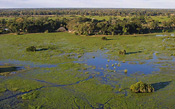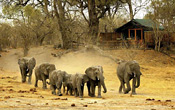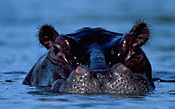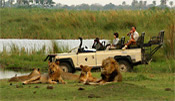Conservation and Tourism
 Botswana
has conserved 17% of its land as National Parks and Reserves and
an additional 22% as Wildlife Management Areas (WMA's). This foresight,
along with strong conservation policies and minimal population
pressure, has given Botswana its unique potential for future ecotourism. Botswana
has conserved 17% of its land as National Parks and Reserves and
an additional 22% as Wildlife Management Areas (WMA's). This foresight,
along with strong conservation policies and minimal population
pressure, has given Botswana its unique potential for future ecotourism.
Botswana's prime policy regarding
tourism is a high revenue, low volume market. They do not wish
to overexploit their wildlife and wilderness resources with mass
tourism, as has happened in much of East Africa. Botswana is committed
to long-term gains, with an emphasis on uplifting its citizens
through tourism and wildlife.
Botswana's National Parks and Game
Reserves are set aside such that no one may live within their borders
(the one exception being the traditional San people in the Central
Kalahari Game Reserve). All visitors must pay an entrance
fee to enter and the number of beds inside these parks and reserves
is quite limited. |
Wildlife Management Areas
(WMA's)
 The system of WMA's
used in Botswana today is part of a land-use strategy called
Community-Based, Natural Resources Management (CBNRM). A national
land-use planning exercise in the mid-1970's, designed to help
foster development in Botswana's rural areas, led first to the
Tribal Grazing Land Policy (TGLP). This policy resulted in the
official zoning of all land into three categories: 'arable' (communal
and commercial), 'grazing', and 'reserved'. The
'reserved' category was land considered to be underutilized
and unsuitable for agriculture. However, this land was typically
used by the various traditional inhabitants of Botswana to hunt
and to gather. Moreover, certain of these areas were also important
wildlife migration routes and were considered buffer zones around
protected areas, which in addition to veterinary fences, acted
as livestock disease barriers. The system of WMA's
used in Botswana today is part of a land-use strategy called
Community-Based, Natural Resources Management (CBNRM). A national
land-use planning exercise in the mid-1970's, designed to help
foster development in Botswana's rural areas, led first to the
Tribal Grazing Land Policy (TGLP). This policy resulted in the
official zoning of all land into three categories: 'arable' (communal
and commercial), 'grazing', and 'reserved'. The
'reserved' category was land considered to be underutilized
and unsuitable for agriculture. However, this land was typically
used by the various traditional inhabitants of Botswana to hunt
and to gather. Moreover, certain of these areas were also important
wildlife migration routes and were considered buffer zones around
protected areas, which in addition to veterinary fences, acted
as livestock disease barriers.
Subsequently, it was
decided that natural resources management was the appropriate
use for these ‘reserved' areas. Today, these areas
are known as Wildlife Management Areas (WMA's). It was
also determined that natural-resource-based management of these
WMA's had to involve local community participation in order to
succeed. However, legislation as to what this local management
would entail, beyond state ownership of all natural resources,
was absent until the 1990's. Numerous conservation-based
policies were enacted during this decade which allowed local
communities to benefit from wildlife, other natural resources,
and tourism.
CBNRM was born out
of these policies of the 1990's and is based on the idea that
the communities living adjacent to or within an area, are the
people most suited to protecting the resources within it. This
premise holds that the local communities stand to lose the most
if those resource are lost, and will gain the most if it's well
managed. Furthermore, the people that suffer the consequences
of living near wildlife (destruction of crops and livestock)
should also be the ones to benefit from its conservation. The
local communities ought to be involved in decisions affecting
the resources they depend upon to survive and they should be
able to benefit from the land on which they live; CBNRM strives
to make all this possible. |
Controlled Hunting Areas
(CHA's)
Subsequent to the
land-use planning exercise of the 1970's, a further land-use strategy
was developed during the late 1980's. In order to support
the potential uses of WMA's, the Ministry of Local Government, Lands
and Housing, and the Department of Wildlife and National Parks (DWNP)
re-zoned all land into Controlled Hunting Areas (CHA's). CHA's are
administrative land blocks used by the DWNP to allocate hunting quotas.
The entire land area of Botswana is now divided into 163 CHA's, which
are zoned for various types of wildlife utilization (including non-consumptive
use), under either commercial or community management. The CHA's are
organized, wherever possible, around existing settlements and those
under community management are designed to benefit the local people.
In practical terms, the WMA's were subdivided into CHA's, which became
the main units of natural resource production. Referring
to the Map of Ngamiland, a concession
(or NG area) is actually a CHA.
Community-Based Management
 The wildlife and tourism-related
policies give part of the responsibility for managing and administering
wildlife to the local communities. A community or group of communities
in or adjacent to a CHA zoned for community management may apply
for a wildlife quota, provided it has organized in a representative
manner sanctioned by the District authorities and the DWNP. The wildlife and tourism-related
policies give part of the responsibility for managing and administering
wildlife to the local communities. A community or group of communities
in or adjacent to a CHA zoned for community management may apply
for a wildlife quota, provided it has organized in a representative
manner sanctioned by the District authorities and the DWNP.
If the community wants
more assured access to the wildlife quota and considers joint ventures
with the private sector (safari operators or professional hunters),
it may decide to lease the CHA from the land authority. In that
case, the community has to organize itself into a legally-registered
Community-based Organization (CBO) with a constitution and by-laws
and also must produce a Land-use and Management Plan. The registered
CBO may, if it so wishes, enter into subleases and/or joint-venture
agreements with private companies for the use of the acquired resource
rights.
The presumption is that
when communities realize economic value from their surrounding
natural resources, they will be inclined to manage them in a more
sustainable way. The overall benefit of CBNRM is considered to
be twofold: rural economic development and the conservation of
Botswana's natural resources. |
Trophy-hunting or Photographic
Once a CBO has entered into a lease for a community-managed CHA, the
agreement gives the community exclusive rights over the wildlife quota. It
can decide whether to hunt the quota or not, and how to hunt it. Species
can be divided among the community members for subsistence hunting or the
quota can be sold to a private-sector partner. Typically, the community sells
the commercially valuable species such as elephant, zebra, lion and leopard
to the private-sector partner. These species have no subsistence use
for local people. Valuable trophy (male) animals among subsistence species,
such as buffalo, eland, gemsbok, sable, wildebeest and kudu are sold, while
the females (meat value) and the lesser antelopes, such as duiker, impala
and springbok, are retained for subsistence hunting. Trophy hunting joint-venture
agreements generate large sums of money at the community level and substantial
employment during the six-month hunting season (April-September).
More
recently, photo safari operators have begun negotiating sub-lease agreements
for use of community-managed CHA's. This has been partly due to the
high demand for this type of tourism and the limited number of beds available. New
safari camps are being built and the number of CHA's allowing hunting is
definitely decreasing. In fact, as little as 10-15 years ago, the
majority of Ngamiland (outside of Moremi GR) was hunting area. To see the
current status of hunting vs. photographic CHA's in the Ngamiland District,
see our Map.
Commercial-Use CHA's
 Under the current
system of CHA's, the private sector may tender for the sole use
of a CHA zoned for commercial use. The lease period may run
for up to 15 years. The land remains in the ownership of the country
and the private sector may not own the land. Once a CHA's lease
has expired, the concession is put up for bid and a rigorous process
of evaluation is conducted by an independent panel of experts who
do not know the identity of the companies submitting bids. Recommendations
are then made to the relevant committee of elected officials, which
makes the final decisions on who wins the tender. The winning operator
is required to match the highest rental bid tendered. The system
is designed to attract the most competent operators, and to ensure
that the local communities, and the country, derive maximum benefit
from the use of its resources for tourism. Under the current
system of CHA's, the private sector may tender for the sole use
of a CHA zoned for commercial use. The lease period may run
for up to 15 years. The land remains in the ownership of the country
and the private sector may not own the land. Once a CHA's lease
has expired, the concession is put up for bid and a rigorous process
of evaluation is conducted by an independent panel of experts who
do not know the identity of the companies submitting bids. Recommendations
are then made to the relevant committee of elected officials, which
makes the final decisions on who wins the tender. The winning operator
is required to match the highest rental bid tendered. The system
is designed to attract the most competent operators, and to ensure
that the local communities, and the country, derive maximum benefit
from the use of its resources for tourism.
Significant revenue is paid to local
sources before profits may be realized by the private sector. Concession
rental is paid to the Land Boards; a resource royalty is paid to
local government agencies; sales tax on accommodation receipts,
and a 25% income tax is paid to the central government. A per-bednight
training levy goes to the Tourism Department, and daily game reserve
entry fees for every visitor also go to the central government.
Companies leasing the concessions must adhere to strict guidelines
designating the use of the 'leased' land. For example, a particular
concession may be allocated 20 beds and 45 kilometres of game drive
roads.
Concession operators pay high annual
fees for each vehicle, aircraft and boat used within the area.
Operators must also employ locals from the area as guides and to
help operate the camp, thus reinforcing the policy of involving
and benefiting the communities living in and around the concessions
and providing a culturally rich experience for the visitor. The
details differ somewhat in the case of a trophy hunting leaseholder,
but the idea is the same. |
 Top
Top  Return to Map of
Botswana
Return to Map of
Botswana
 For a map of Safari Camps in the Okavango Delta and Moremi Game
Reserve, click Okavango
Camps For a map of Safari Camps in the Okavango Delta and Moremi Game
Reserve, click Okavango
Camps
 For a map of Safari Camps in the Linyanti, Selinda, Kwando, and Chobe Game Reserve, click Chobe / Linyanti
Camps For a map of Safari Camps in the Linyanti, Selinda, Kwando, and Chobe Game Reserve, click Chobe / Linyanti
Camps
 Water
/ Land Activity Table for Botswana camps: Water/Land
Botswana Water
/ Land Activity Table for Botswana camps: Water/Land
Botswana
 Flying
Times between Botswana camps: Fly
Times Botswana Flying
Times between Botswana camps: Fly
Times Botswana
 For further information about Botswana, click More
Botswana
For further information about Botswana, click More
Botswana
 For further information about the Moremi Game Reserve, click More
Moremi
For further information about the Moremi Game Reserve, click More
Moremi
|